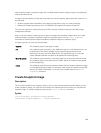
operation. You can ensure that copy-on-write operations maintain a correct
interval by using this option. The maximum value for the scheduleInterval
option is 1440 minutes. For example: scheduleInterval=180.
endDate
Specific date to stop creating a snapshot (legacy) virtual disk and end the copy-on-
write operations. The format for entering the date is MM:DD:YY, where MM is the
month, DD the day and YY the year. For example: endDate=11:26:11.
timesPerDay
The number of times you want the snapshot schedule to run in a day. For example,
timesPerDay=4.
timeZone
Use this parameter to define the time zone in which the storage array is operating.
You can define the time zone in one of two ways:
• GMT±HH:MM—The time zone offset from Greenwich Mean Time (GMT), in hours
and minutes. For example, GMT-06:00 is the central time zone in the United
States.
• Text string—A standard time zone text string, in quotation marks. For
example, "USA/Chicago" or "Germany/Berlin". Time zone text strings are case
sensitive. If you enter an incorrect text string GMT is used.
The code string for defining a schedule is similar to these examples:
enableSchedule=true schedule startTime=14:27
enableSchedule=true schedule scheduleInterval=180
enableSchedule=true schedule timeZone=GMT-06:00
enableSchedule=true schedule timeZone="USA/Chicago"
If you also use the scheduleInterval option, the lowest value of the timesPerDay option and the
scheduleInterval option is used. The firmware calculates an integer value for the
scheduleInterval option by dividing 1440 by the scheduleInterval option value that you set. For
example, 1440/180 = 8. The firmware then compares the
timesPerDay integer value with the calculated
scheduleInterval integer value and uses the smaller value.
To remove a schedule, use the delete virtualDisk command with the schedule parameter. The
delete virtualDisk command with the schedule parameter deletes only the schedule, not the
snapshot (legacy) virtual disk.
Create Snapshot Virtual Disk
Description
This command creates a snapshot virtual disk for snapshot images of a base virtual disk. You can assign
the new snapshot virtual disk to an existing repository disk group or disk pool, or you can create a new
repository disk group or disk pool if one does not already exist.
NOTE: You cannot use this command for a snapshot image that is used in online virtual disk copy.
196


















